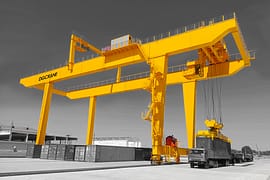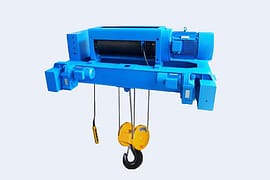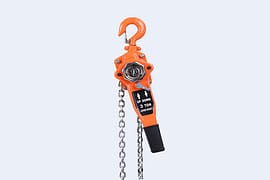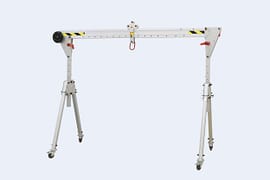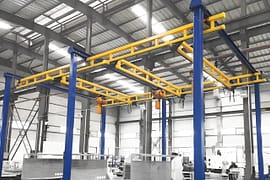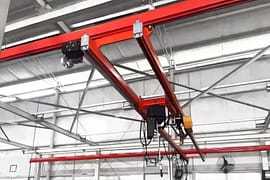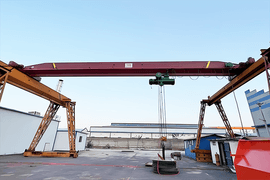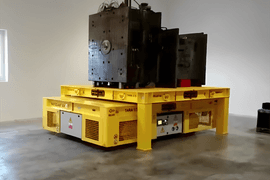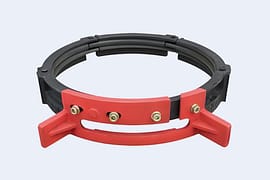-
INDUSTRIES
-

Precast Concrete Plant
-

Steel Industry
-

Paper Industry
-

Waste to Energy and Biomass Industry
-

Power Industry
-

Overhead Cranes for Automotive Production: Smart Solutions for Enhanced Efficiency
-

Port Machines Industry
-

Manufacturing Industry
-

Different Types of Container Cranes, Shipyard Cranes, Cargo Cranes Used in Port, Harbor and Quay
-
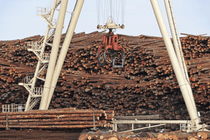
Overhead Cranes for Timber Lifting: Efficient and Safe Wood Handling
-

Overhead Cranes for the Aviation Industry: Streamlining Aircraft Assembly, Maintenance, and Repair
-

Overhead Cranes for Food and Beverages: Ideal for improving productivity and food safety
-
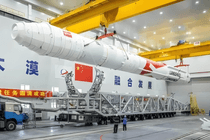
Overhead Cranes for Aerospace Industry: Key Role in Efficient Rocket Manufacturing and Launch
-
-
EQUIPMENT
-
Overhead Cranes
-

Single Girder Overhead Crane
-

Double Girder Overhead Crane
-

Underslung Cranes
-

Workstation Overhead Cranes
-

Low Headroom Overhead Cranes
-

Grab Bucket Overhead Crane
-

Electromagnetic Overhead Cranes with Lifting Magnet
-

Electromagnetic Overhead Cranes with Magnet Beam
-

Manual Overhead Cranes
-

Double Trolley Overhead Cranes
-

LDP Single Girder Overhead Cranes
-
- Eot Cranes
- Gantry Cranes
- Jib Cranes
- FEM Standard Crane & Hoist
- Hoist & Winch Trolley
- Light Cranes
- Explosion Proof Cranes and Hoists
-
Special Cranes
-

35-65t Clamp Overhead Crane
-

Boat Hoists
-

Boat Jib Crane
-

Yacht Davit Crane
-

Rail Mounted Container Gantry Crane
-

Cleanroom Overhead Cranes
-

YZ Ladle Handling Cranes
-

LDY Metallurgical Single Girder Crane
-

Charging Cranes for Steel Production
-

Insulated Overhead Cranes
-

Gantry Crane for Subway and Metro Construction
-
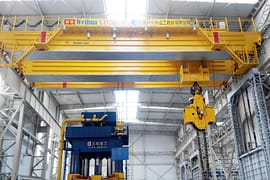
Forging Crane
-

Quenching Overhead Crane
-

Baking Multifunctional Crane
-
- Port Cranes
- Electric Transfer Carts
-
Overhead Cranes
-
CRANE PARTS
- Crane Wheel Range
- Crane Spreader
- Crane Drives
-
Crane Electrical Equipment
-

Overload Limiter
-

Crane Cabin
-

Crane Power Supply System
-

Explosion Proof Crane Radio Remote Controls
-

Joystick Type Crane Radio Remote Controls
-
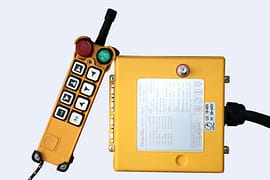
Pushbutton Type Crane Wireless Remote Controls
-

Single-pole Insulated Conductor Rails
-

Enclosed Conductor Rails
-

Seamless Conductor Rails
-

Copperhead Conductor Rails
-

Overhead Crane Cables
-
- Other Cranes Parts
\
- ABOUT US
- CONTACT US
When do you check a Limit Switch? Many people understand this regulation completely wrong. There are many others that think that they don’t need to check the limit switch, and of course others who don’t want to check it because they are worried about it failing. This of course is the exact reason why you should be checking. So when do you check a limit switch? Well, if you said daily you are wrong again. You should be checking it each shift! That is the correct answer. If your facility has more than one shift then it needs to be checked at the beginning of that shift. Checking it only once a day opens the door for something to potentially to happen because the next operator has no idea what was done on the first shift. So, please for your own good check the limit switch on the beginning of each of your facility’s shift.
Another idea that floats around that I hear when I visit my customers is that the limit switch needs to be tested under a load. That answer is absolutely false. You should never check the limit switch under a load. For that matter you should never check any part of the crane or hoist under a load. The only time a load should be on the hook during a test is during a load test and that should be done by professional crane technicians.
Many companies are very worried and tell their crane operators to skip the limit switch inspection. They worry that it may get stuck or does not work. I tell you if there ever is a time you want to find that out, it is during an inspection, you don’t want to find out while you’re making a vital pick. To inspect the upper limit you should be inching the load block into the limit switch. Do not go right into high speed. Go in slow speed or if you have a single speed hoist then jog the pendant so the load block is inched into the limit switch.
Many manuals will suggest you to go into high speed. Me personally, I leave that to the operator. You can after you jog it into the limit switch. However be prepared that the load block may not stop at the same point that it stopped when you jogged it into the limit switch. Just like a car, the faster you go the longer it will take to slow down; at least if you have a VFD that is how it would work. So be careful!
?A second fable that exists in the crane world is pretty much the exact opposite of what I just told you. I have talked to many customers that think that they can use the limit switch at an operational device. When I say operation device I mean that they think they can use the limit switch every time they operate the hoist. There are many applications that would require the load block to reach its upper most limit in order to get the most height out of the load hook as you possibly can. However unless you have two limit switches on your hoist this is not allowed or recommended. A limit switch is designed as a safety device only; so constant operation was not applied to the engineering of the device. This can decrease the life of the limit switch since many are made out of plastic. If your crane is equipped with two limit switches than you should check with your overhead crane contractor to see if you can utilize the limit switch as an operating device.
You should be having a crane company come in quarterly, semi-annually, or annual depending on the usage of your crane. During this time it is a good time to talk to your crane contractor too see what they recommend for performing your daily, and monthly inspections. Depending on your crane you may want to inspect it differently from what I have suggested.




Zora Zhao
Expert in Overhead Crane/Gantry Crane/Jib Crane/Crane Parts Solutions
With 10+ years of experience in the Crane Overseas Export Industry, helped 10,000+ customers with their pre-sales questions and concerns, if you have any related needs, please feel free to contact me!
WhatsApp: +86 189 3735 0200
Email: zorazhao@dgcrane.com
Related Blogs
Subscribe to our newsletter
The latest DGCRANE price list, news, articles, and resources.
- Overhead Cranes
- Low Headroom Overhead Cranes
- Double Girder Overhead Crane
- Grab Bucket Overhead Crane
- Top Running Overhead Crane: Wide Application and Easy Maintenance
- Coker Cranes for Harsh Environments: High Temperature and Corrosion Resistant Design
- Overhead Cranes for Concrete Pile Precast Workshop: Versatile Solutions for Demanding Operations
- Single Girder Overhead Cranes
- Eot Cranes
- Single Girder Eot Cranes
- Double Girder Eot Cranes
- Underslung Cranes
- Light Cranes
- Adjustable Gantry Cranes: Easy to Move, Safe, and Space-Efficient
- Foldable Aluminum Gantry Crane: Lightweight, Strong, and Portable
- Freestanding Workstation Bridge Crane: Lightweight, Modular and Adaptable Material Handling Solution
- Ceiling Mounted Workstation Bridge Crane: Ideal for Tight Spaces and Complex Layouts
- Workstation Overhead Cranes
- Monorail Overhead Cranes
- Workstation Jib Cranes
- Electric Hoists
- Gantry Cranes
- Shipyard Gantry Cranes: Specialized Lifting Solutions for Shipyard Operations
- Truss Gantry Cranes: Cost-Effective, Wind-Resistant, and Perfect for Large Spans
- Different Types of Small Portable Aluminium Gantry Cranes: Cost Effective
- Single Girder Gantry Cranes
- Double Girder Gantry Cranes
- Semi Gantry Cranes
- Casting Yard Gantry Cranes
- Container Gantry Cranes: RTG & RMG Solutions for Ports and Terminals
- Portable Mobile Gantry Cranes: Flexible, Movable and Space-Saving
- FEM Standard Crane & Hoist
- FEM Standard Overhead Cranes
- FEM Standard Gantry Cranes
- FEM Standard Jib Cranes
- FEM Standard Wire Rope Electric Hoists
- FEM Standard Electric Chain Hoists
- Hoist & Winch Trolley
- Low Headroom Wire Rope Electric Hoist: Compact Design for Efficient Lifting in Tight Spaces
- Electric Hoist for Molten Metal: High-Temperature, Safe Lifting for Metallurgical Environments
- Pneumatic (Air) Chain Hoists: Ideal for Explosion-Proof Environments
- Lever Hoists: Compact, Versatile Manual Lifting Tool
- 6 Double Girder Trolley Electric Hoists for Overhead Cranes: Custom Solutions for Every Lifting Need
- Manual Chain Hoists: Alloy Steel Construction for Smooth and Safe Lifting
- Electric Wire Rope Hoists
- Chain Hoists
- Crane Trolley
- Electric Winch
- Explosion Proof Cranes and Hoists
- Explosion Proof Single Girder Overhead Cranes: Safe Lifting Solution for Hazardous Environments
- Explosion Proof Wire Rope Electric Hoist: Upgrade Your Safe
- Explosion Proof Electric Chain Hoist of High Qualit
- Explosion Proof Manual Chain Hoist: Safety in Every Lift
- Explosion Proof Double Girder Overhead Crane: More Cost Effective
- Port Cranes
- Rubber Tyred Container Gantry Crane
- Ship To Shore Crane
- Container Straddle Carrier
- Harbour Portal Crane
- Shipyard Portal Cranes
- Container Gantry Cranes: RTG & RMG Solutions for Ports and Terminals
- Reliable Versatile Electric Transfer Carts
- AGV Transfer Carts
- Powerful Heavy Duty Coil Transfer Carts
- RGV Transfer Carts
- Powerful Pallet Transfer Carts
- Trackless Transfer Carts
- Reliable Heavy Duty Ladle Transfer Cars
- Superior Die Transfer Carts
- Rail Transfer Carts
CRANE PARTS
- Special Cranes
- Rail Mounted Container Gantry Crane
- Cleanroom Overhead Cranes: Reliable Solutions for Healthcare, Electronics, and GMP Workshops
- Charging Cranes for Steel Production: Safe and Reliable Solutions for Efficient Material Handling
- Insulated Overhead Cranes for Safe Non-Ferrous Metal Smelting
- Gantry Crane for Subway and Metro Construction: Efficient Tunnel Debris Removal Solutions
- Quenching Overhead Crane for Heat Treatment Plant: High-Temperature Insulated and Efficient Lifting Solution
- Heavy Duty Forging Cranes: Durable, High-Capacity Solutions for Forging
- Baking Multifunctional Crane: Furnace Tending Assembly for Efficient Carbon Roasting
- 35-65t Clamp Overhead Crane
- Boat Hoists
- Yacht Davit Crane
- Boat Jib Crane
INDUSTRIES
- Steel Industry
- Paper Industry
- Power Industry
- Overhead Cranes for Automotive Production: Smart Solutions for Enhanced Efficiency
- Port Machines Industry
- Manufacturing Industry
- Overhead Cranes for Timber Lifting: Efficient and Safe Wood Handling
- Overhead Cranes for the Aviation Industry: Streamlining Aircraft Assembly, Maintenance, and Repair
- Overhead Cranes for Food and Beverages: Ideal for improving productivity and food safety
- Overhead Cranes for Aerospace Industry: Key Role in Efficient Rocket Manufacturing and Launch
- Precast Concrete Plant
- Waste to Energy and Biomass Industry
- Different Types of Container Cranes, Shipyard Cranes, Cargo Cranes Used in Port, Harbor and Quay
COMPANY
- sales@dgcrane.com
- +86 373 387 6188
- +86 189 3735 0200
- Floor 30,Gongyuan INT'I Building, Jinsui Road, Xinxiang City, Henan Province, China






